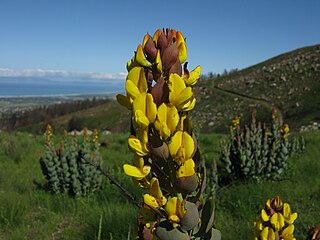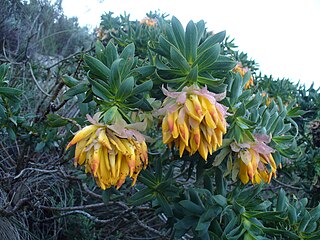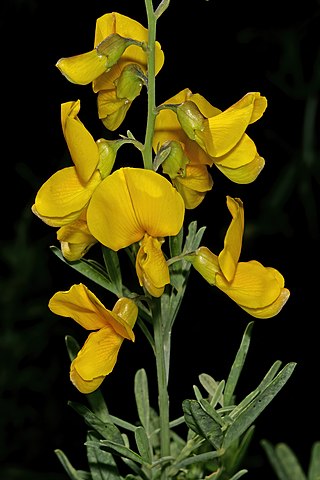
The Faboideae are a subfamily of the flowering plant family Fabaceae or Leguminosae. An acceptable alternative name for the subfamily is Papilionoideae, or Papilionaceae when this group of plants is treated as a family.
Calobota linearifolia is a species of flowering plant in the family Fabaceae.

Lotononis is a genus of flowering plants in the family Fabaceae and the tribe Crotalarieae. The genus includes 99 species of annual and perennial herbs, native to the southeastern Europe and Turkey, eastern Africa, and southern Africa.

Crotalarieae is a tribe of flowering plants belonging to the family Fabaceae. It includes rooibos (Aspalathus linearis), harvested for sale as a tisane.

Argyrolobium is a genus of flowering plants in the family Fabaceae. It belongs to the subfamily Faboideae. Members of this genus are found in Africa, western and south Asia, and southern Europe.

Lessertia is a genus of flowering plants in the legume family, Fabaceae. It contains some 62 species native to eastern and southern Africa. It belongs to subfamily Faboideae.

Rafnia is a genus of flowering plants in the family Fabaceae. It includes 29 species of shrubs and subshrubs native to South Africa. They grow in Mediterranean-climate fynbos (shrubland) and grassland, mostly on rocky and sandy soils. Most are native to the Cape Provinces, with some extending eastwards into KwaZulu-Natal. It belongs to subfamily Faboideae.

The tribe Podalyrieae is one of the subdivisions of the plant family Fabaceae.

Liparia is a genus of flowering plants in the legume family, Fabaceae. It includes 20 species native to the Cape Provinces of South Africa. It belongs to the subfamily Faboideae.

Leobordea is a genus of legumes in the family Fabaceae and the tribe Crotalarieae. Members of this genus are found in the eastern parts of South Africa as well as tropical Africa and the Mediterranean countries. It was recently segregated from the genus Lotononis.

The inverted repeat-lacking clade(IRLC) is a monophyletic clade of the flowering plant subfamily Faboideae (or Papilionaceae). Faboideae includes the majority of agriculturally-cultivated legumes. The name of this clade is informal and is not assumed to have any particular taxonomic rank like the names authorized by the ICBN or the ICPN. The clade is characterized by the loss of one of the two 25-kb inverted repeats in the plastid genome that are found in most land plants. It is consistently resolved in molecular phylogenies. The clade is predicted to have diverged from the other legume lineages 39.0±2.4 million years ago (in the Eocene). It includes several large, temperate genera such as AstragalusL., HedysarumL., MedicagoL., OxytropisDC., SwainsonaSalisb., and TrifoliumL..
Maraniona lavinii is a species of legume in the family Fabaceae, and was recently assigned to the informal monophyletic Pterocarpus clade of the Dalbergieae. It is endemic to the Marañón Valley in northern Peru. It is the only member of the genus Maraniona and is closely related to the genus Tipuana.

Calobota is a genus of flowering plants in the legume family, Fabaceae. It includes 16 species native to North Africa and southern Africa. It belongs to the subfamily Faboideae.
Wiborgiella is a genus of flowering plants in the family Fabaceae. It belongs to the subfamily Faboideae.

The Genistoids are one of the major radiations in the plant family Fabaceae. Members of this phylogenetic clade are primarily found in the Southern hemisphere. Some genera are pollinated by birds. The genistoid clade is consistently resolved as monophyletic in molecular phylogenetic analyses. It is estimated to have arisen 56.4 ± 0.2 million years ago. A node-based definition for the genistoids is: "the MRCA of Poecilanthe parviflora and Lupinus argenteus." One morphological synapomorphy has been tentatively identified: production of quinolizidine alkaloids. Some genera also accumulate pyrrolizidine. A new genus, to be segregated from Clathrotropis, has also been proposed to occupy an undetermined position within the genistoid clade.

The dalbergioids are an early-branching monophyletic clade of the flowering plant subfamily Faboideae or Papilionaceae. They are pantropical, particularly being found in the neotropics and sub-Saharan Africa. This clade is consistently resolved as monophyletic in molecular phylogenetic analyses. It is estimated to have arisen 55.3 ± 0.5 million years ago. A node-based definition for the dalbergioids is: "The least inclusive crown clade that contains Amorpha fruticosaL. 1753 and Dalbergia sissooRoxb. ex DC. 1825." Indehiscent pods may be a morphological synapomorphy for the clade.

Genisteae is a tribe of trees, shrubs and herbaceous plants in the subfamily Faboideae of the family Fabaceae. It includes a number of well-known plants including broom, lupine (lupin), gorse and laburnum.

The Mirbelioids are an informal subdivision of the plant family Fabaceae that includes the former tribes Bossiaeeae and Mirbelieae. They are consistently recovered as a monophyletic clade in molecular phylogenies. The Mirbelioids arose 48.4 ± 1.3 million years ago. Members of this clade are mostly ericoid (sclerophyllous) shrubs with yellow and red flowers found in Australia, Tasmania, and Papua-New Guinea. The name of this clade is informal and is not assumed to have any particular taxonomic rank like the names authorized by the ICBN or the ICPN. Members of this clade exhibit unusual embryology compared to other legumes, either enlarged antipodal cells in the embryo sac or the production of multiple embryo sacs. There has been a shift from bee pollination to bird pollination several times in this clade. Mirbelioids produce quinolizidine alkaloids, but unlike most papilionoids, they do not produce isoflavones. Many of the Mirbelioids have pseudoraceme inflorescences.















